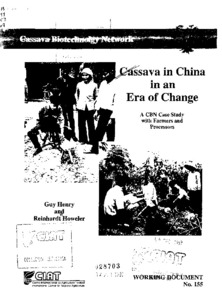CGIAR is the only worldwide partnership addressing agricultural research for development, whose work contributes to the global effort to tackle poverty, hunger and major nutrition imbalances, and environmental degradation.
It is carried out by 15 Centers, that are members of the CGIAR Consortium, in close collaboration with hundreds of partners, including national and regional research institutes, civil society organizations, academia, development organizations and the private sector.
The 15 Research Centers generate and disseminate knowledge, technologies, and policies for agricultural development through the CGIAR Research Programs. The CGIAR Fund provides reliable and predictable multi-year funding to enable research planning over the long term, resource allocation based on agreed priorities, and the timely and predictable disbursement of funds. The multi-donor trust fund finances research carried out by the Centers through the CGIAR Research Programs.
We have almost 10,000 scientists and staff in 96 countries, unparalleled research infrastructure and dynamic networks across the globe. Our collections of genetic resources are the most comprehensive in the world.
What we do
We collaborate with research and development partners to solve development problems. To fulfill our mission we:
- Identify significant global development problems that science can help solve
- Collect and organize knowledge related to these development problems
- Develop research programs to fill the knowledge gaps to solve these development problems
- Catalyze and lead putting research into practice, and policies and institutions into place, to solve these development problems
- Lead monitoring and evaluation, share the lessons we learn and best practices we discover;
- Conserve, evaluate and share genetic diversity
- Strengthen skills and knowledge in agricultural research for development around the world
Making a difference
We act in the interests of the world’s poorest and most vulnerable. Our track record spans four decades of research.
Our research accounted for US$673 million or just over 10 percent of the US$5.1 billion spent on agricultural research for development in 2010. The economic benefits run to billions of dollars. In Asia, the overall benefits of CGIAR research are estimated at US$10.8 billion a year for rice, US$2.5 billion for wheat and US$0.8 billion for maize.
It has often been cited that one dollar invested in CGIAR research results in about nine dollars in increased productivity in developing countries.
Sweeping reforms for the 21st century
Political, financial, technological and environmental changes reverberating around the globe mean that there are many opportunities to rejuvenate the shaky global food system. Developments in agricultural and environmental science, progress in government policies, and advances in our understanding of gender dynamics and nutrition open new avenues for producing more food and for making entrenched hunger and poverty history.
The sweeping reforms that brought in the CGIAR Consortium in 2010 mean we are primed to take advantage of these opportunities. We are eagerly tackling the ever more complex challenges in agricultural development. We are convinced that the science we do can make even more of a difference. To fulfill our goals we aim to secure US$1 billion in annual investments to fund the current CGIAR Research Programs.
CGIAR has embraced a new approach that brings together its strengths around the world and spurs new thinking about agricultural research for development, including innovative ways to pursue scientific work and the funding it requires. CGIAR is bringing donors together for better results and enabling scientists to focus more on the research through which they develop and deliver big ideas for big impact. As a result, CGIAR is more efficient and effective, and better positioned than ever before to meet the development challenges of the 21st century.
We are no longer the ‘Consultative Group on International Agricultural Research’. In 2008 we underwent a major transformation, to reflect this and yet retain our roots we are now known simply as CGIAR.
Members:
Resources
Displaying 11791 - 11795 of 12598Cassava in China in an era of change: a CBN case study with farmers and processors
Carcass characteristics of adult sheep and goat breeds in the subhumid and semi-arid zones of Cameroon
Data from slaughter (LWT) and warm carcass (HCWT) weights and dressing-out percentages (CYD%) of 209 Uda (Sahel) and 26 Djallonke sheep and 105 Djallonke goats were analysed by fitting a least-squares fixed-effects model. The model consisted of the effects of breed and sex on LWT and CYD% and the effects of breed, sex and LWT (as covariate) on HCWT for the sheep data. The effect of sex alone on LWT and CYD% was fitted for the goat data. As for the goat carcass data, HCWT was regressed on LWT for each sex subclass. Effect of breed significantly affected all carcass traits in the sheep.
Bugis settlers in East Kalimantan’s Kutai National Park: their past and present and some possibilities for their future
What policies should be adopted regarding enclave populations in national parks and other protected areas and how should the policies be implemented? These questions are important for protected areas throughout the world. Andrew P. Vayda and Ahmad Sahur report here on socio-economic and historical research that they conducted in the rapidly industrialising Indonesian province of East Kalimantan to help deal with such questions.
Assessing people's perceptions of forests in Danau Sentarum Wildlife reserve
Previous research identified three important issues of relevance to forest people's roles in sustain- able forest management which we address here: the presence of a Conservation ethics, a feeling of closeness to the forest, and a significant forest-culture link. In this paper we examine a method (the Galileo), recently pre-tested for this purpose in West Kalimantan, which we hope can help us to assess such issues quickly, reliably and in a quantitative manner amenable to use by would-be assessors of various educational and experiential levels.



